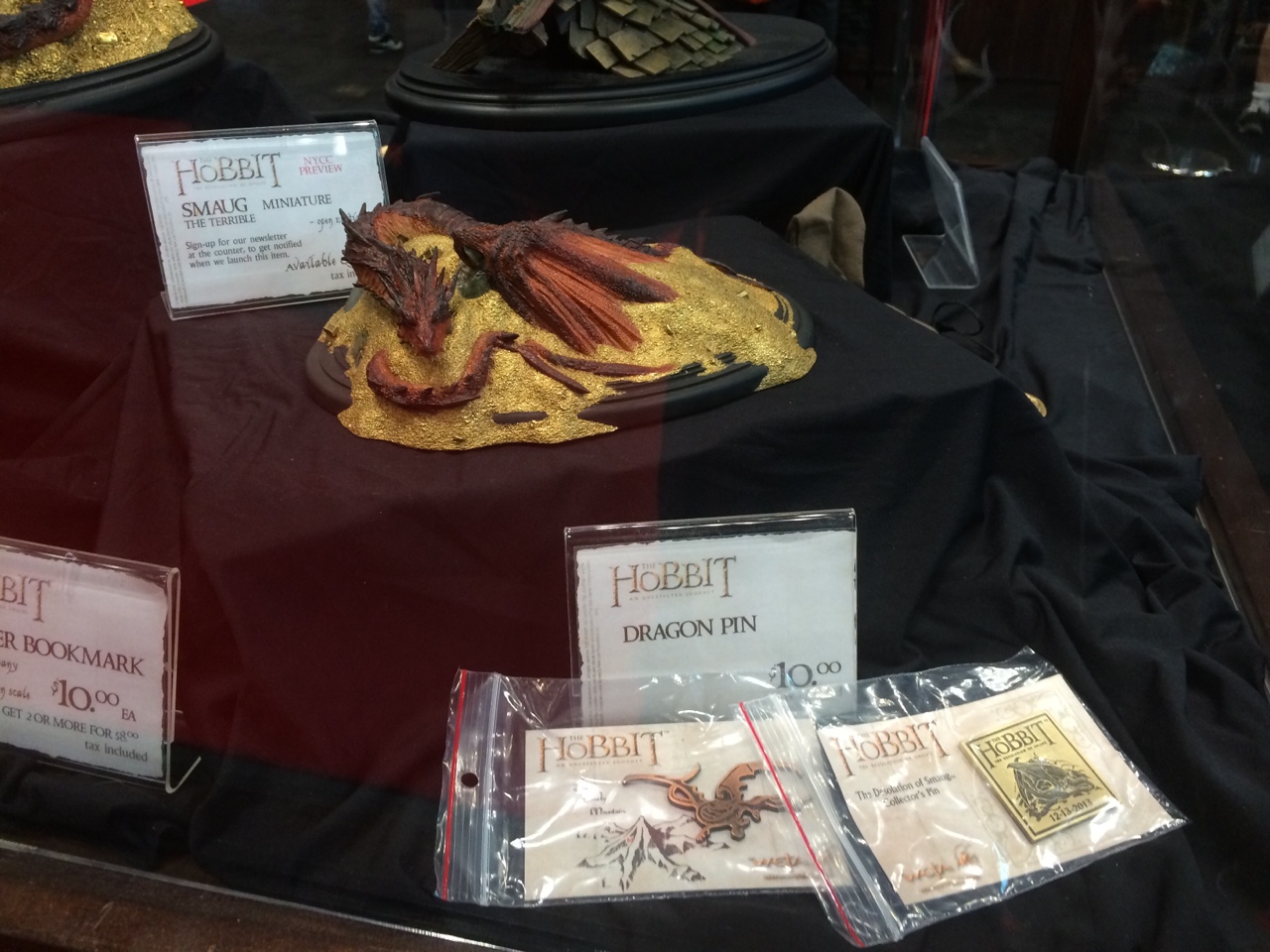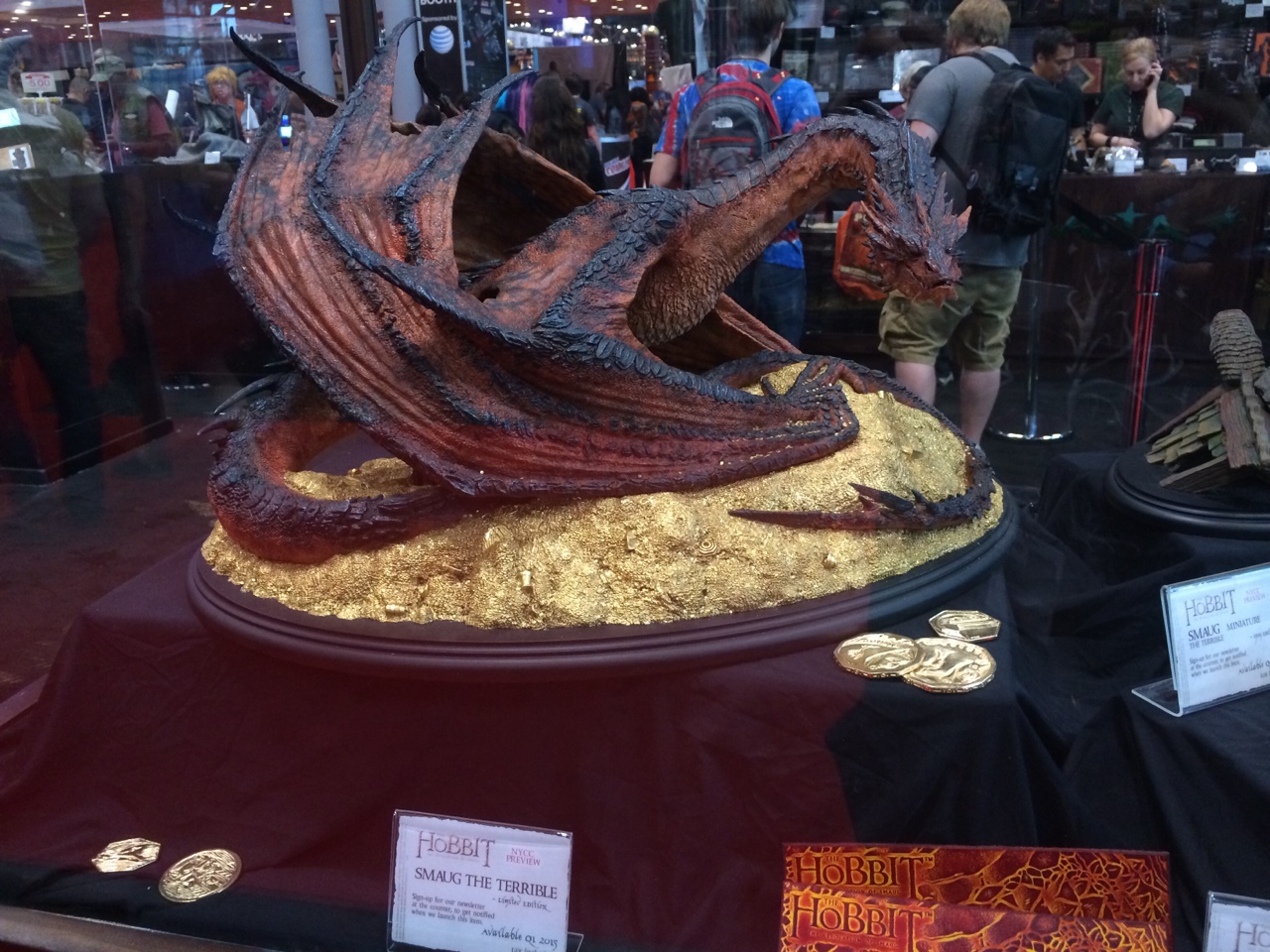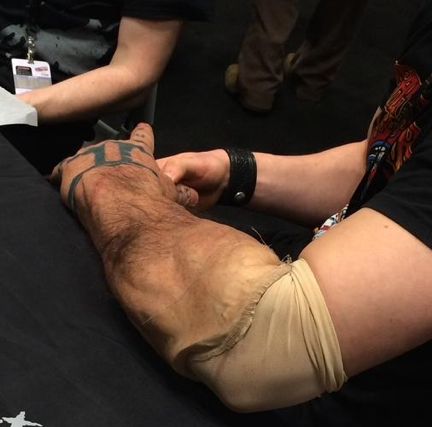One of the highlights for me at New York Comic Con was definitely the Weta Workshop booth. The first day, I didn’t even buy anything because the choices were so overwhelming! I wanted everything. They had many items available to purchase that would make any Tolkien fan reach for their wallet. I should also mention the giant Smaug head whose eyes would occasionally open and look around menacingly. There were many statues on display, including two Smaug ones which are shown below. There were awesome t-shirts for sale, hobbit ears to buy, books to peruse…so much to look at! It was no surprise that their booth was packed from opening to closing.
Along with the fantastic items, two Weta Workshop artists, Nick Keller and Paul Tobin, were there to chat with fans and sign books and prints. They were both incredibly nice and seemed just as excited as the attendees to be at NYCC. They would not only sign their names, but they would even include small sketches. Richard Taylor made a surprise visit on Thursday. Sadly I missed it!
Weta NYCC booth photos courtesy of Eleni Mutafopulos.
On Saturday, Paul and Nick hosted a panel entitled “The Hobbit: Designing Dwarves and Elves” where they shared information and experiences while working on The Hobbit. They started out talking about how The Hobbit gave them the chance to really explore the dwarven culture, something that wasn’t done as much for The Lord of the Rings trilogy. They admitted that it was challenging to try and make each of the dwarves have his own individual appearance, they had the task of making each character look unique and distinguishable simply from their silhouette. With 13 of them, I can only imagine the time and effort it took to accomplish that, which they did so beautifully. Even though it took a while, I can now quickly tell who is Bifur, who’s Oin, who’s Balin. It was very important that Weta made each of the dwarves look different and have their own personality.
It was shocking to find out that Weta did about 600-700 different beard and hair designs. Man, I’d love to see all of them! The hair used for the final designs were made from yak hair, because if human hair was used the dwarves would look like they were “in a Pantene commercial.” Nick and Paul showed photos of early concept drawings they did on Weta employees in addition to Alan Lee and John Howe. The artists wanted to see how far they can go before their designs would start to look like something from a cartoon.
Before The Hobbit films were a thing, the most experience Weta had with dwarves was with Gimli. Yes there were other dwarves shown in LOTR, but Gimli was the main one. Paul and Nick talked about how he was basically 100% prosthetics. “When Gimli is talking, the beard is talking.” This was something Weta needed to make sure they could work around for The Hobbit. If you’ve watched the behind-the-scenes footage from the LOTR films, you may already know that John Rhys-Davies had some difficulties with the prosthetics he had to wear. Because actors such as Richard Armitage, Ken Stott and Aidan Turner had a lot of dialogue, they weren’t given as much prosthetics as other actors like Stephen Hunter. Nick and Paul discussed the challenges of making dwarves look like dwarves while still being able to film for long periods of time.
In order for the actors to be able to wield and use their weapons, the palm of the hand prosthetics were removed, and Nick actually wore Dwalin’s arm prosthetic during the panel (and for the majority of the rest of the day!) so we could see first hand what it looks like.
Later on during the panel, Nick’s initial designs for Thror were shown, and interestingly enough, those designs were actually the inspiration for those giant dwarf statues you see the Company climb in The Desolation of Smaug. It’s good to know that they managed to still incorporate Nick’s work even if it didn’t end up on the character in the end.
Next, Paul and Nick showed slides for each of the dwarves, and talked a little about what it took to make that character a reality. It started out with Thorin, who they said was “a tough nut to crack.” Since Thorin has such a large role in the trilogy, they didn’t want his character design to distract too much from Richard’s performance. Also something that I thought was really interesting was that the younger the dwarves are the more “manish” they look. This is why older dwarves such as Balin and Oin have more pronounced noses and ears, while Kili and Fili don’t.
The next dwarf to be featured was Dwalin. “He’s the bouncer,” Paul added. Graham McTavish really wanted his character to have tattoos which you can see a little of in the photo above. Next up was Gloin, and for this particular character, the conceptual artists already had an idea of what he should look like because of his son, Gimli. Nick and Paul discussed how they wanted to have him close in appearance to Gimli, close enough that when you see him for the first time you automatically can tell who he is. They both have that red hair, and what’s better they both have the same weapon, an ax. It was a nice touch because it shows that Gloin would have passed down his weapon to his son. Hearing this totally made me “awww” a little.
I got really excited when the next dwarf came up because it was Nori. Nori’s design is so unique, there’s no way he can be mixed up with any other dwarf. We have Paul Tobin to thank for the star hairstyle. It turns out that the folks at Weta really wanted Jed Brophy to have a role in The Hobbit, so they tried to come up with the most outrageous and interesting designs for Nori to make sure that Jed got the part. It’s those little things that put a smile on your face to find out how close the cast and crew are for these films.
The “little boy of the group” (as said by Paul) was after Nori, and I think you all know who I’m talking about: Ori! “He looks like a kid dressing two sizes too big,” Paul said. He and Nick talked about his bowl cut and how Mark Hadlow, who plays Dori, has a headcanon about Ori’s hair. His theory is that Dori would be the one to give Ori his “bowl haircuts”, and because Ori would move around, the hair would be cut unevenly.
When Balin’s slide came up, Nick and Paul pointed out that for his design, his upper lip is completely clear, which not only made it easier for Ken Stott to talk, but easier for us to understand him. Even though he has a clear upper lip, he still has a killer white beard!
Nick and Paul discussed a little about the weapons the dwarves fought with, it was very interesting because they mentioned things that I didn’t really pay attention to before. For instance, the closer you get to the royal family (Thorin, Fili and Kili), the more refined the weapons are. I thought that was a very subtle idea that works beautifully in the films.
Occasionally Peter Jackson would give the artists little doodles of how he wants something to look, and the artists would work hard to try and execute that idea so that Peter would approve it. Oin’s ear trumpet is an example of this, Peter gave the artists a very sketchy drawing of what he thought it should look like. I did not write down all the information, but I believe it was Paul Tobin who fleshed out the drawing and gave it to Peter to approve. Please correct me if I’m wrong!
The last thing Nick and Paul discussed for the dwarves was the armor. They discussed the importance of making it look authentic and appealing while making sure it is still functional for the actors. So not only did it have to look good, it had to work well.
I just want to apologize for the quality of the following photos, my phone did the best it could do!
Because the panel only lasted 45 minutes, Nick and Paul needed to quickly move onto the elves, which elicited some excited murmurs throughout the audience. They went through the different lines of elves, and discussed how Silvan elves “like their drink” and are more “feral” than other elves. They then showed slides for the different Elven locations such as Lothlorien, Rivendell and Mirkwood. One of them said, “When you go to Rivendell you want to hug everyone and have a picnic.” And when you go to Mirkwood, you probably just want to have a drink! They mentioned that they were excited to go back to Rivendell because they got to revisit familiar designs, but also because they could come up with new ones.
The rest of the panel went by rather quickly because of time restraints. What came up next was the costume designs they needed to create for the Mirkwood elves. They wanted them to appear more “prickly” than the ones you would find in say, Lothlorien. They showed us early designs that were created for Tauriel, Legolas and Thranduil, including an early design from when Guillermo del Toro was set to direct The Hobbit. Unfortunately there was no time left for questions, but that’s okay. It was so great to find out more about the behind-the-scenes work it took to bring all the characters to life.














































One Comment